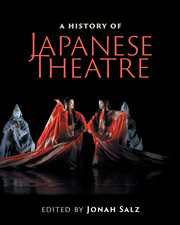Book contents
- Frontmatter
- Contents
- List of figures
- List of tables
- Contributors
- Contributors’ biographies
- Foreword
- Acknowledgments
- Note on Japanese terms
- List of abbreviations
- Timeline
- Editor's introduction
- I Traditional theatres
- Preface to Part I Japanese civilization arises
- II Modern theatres
- Preface to Part II
- III Arcs and patterns
- IV Theatre architecture
- Preface to Part IV Evolution of Japanese theatre architecture
- V Theatre criticism
- VI Intercultural influences
- Epilogue: Frozen words and mythology
- Further reading
- Index
Foreword
Published online by Cambridge University Press: 05 July 2016
- Frontmatter
- Contents
- List of figures
- List of tables
- Contributors
- Contributors’ biographies
- Foreword
- Acknowledgments
- Note on Japanese terms
- List of abbreviations
- Timeline
- Editor's introduction
- I Traditional theatres
- Preface to Part I Japanese civilization arises
- II Modern theatres
- Preface to Part II
- III Arcs and patterns
- IV Theatre architecture
- Preface to Part IV Evolution of Japanese theatre architecture
- V Theatre criticism
- VI Intercultural influences
- Epilogue: Frozen words and mythology
- Further reading
- Index
Summary
I saw my first bunraku performance in Japan in 1951 and my first ever kabuki performance at the Shimbashi Embujō theatre in Tokyo in 1952. It was the height of the Korean War and I was a soldier passing through Japan. In addition to soldiering, I was a theatre-crazy young man. Having lived in New York City the previous year, with endless opportunities to see straight shows, musicals, ballet, and opera, I was confident that I knew what theatrical performance was all about. The two performances that I saw, and heard, in Japan shattered this misguided assurance. The vocal power of the kabuki actor and puppet narrator was beyond anything I could imagine. Nor could I take my eyes off the performers' expressive bodies, frozen into dynamic poses or moving with a powerful physical presence. The whole performance was imbedded within a web of music and sound effects, strange sounding but hypnotic. From those two experiences I set myself a goal of learning more and more about bunraku and, especially, kabuki.
Not only myself, but many others in the United States and Europe, have turned to Japanese theatre to learn new dimensions of theatrical art. As I've written elsewhere about the training in Asian forms:
[P]articipation in theatre provides the potential for a direct experience in alternative human, cultural, and artistic forms. No and kyogen show us alternatives to our often harried and fragmented lives. They show the possibility of beauty that derives from order, of quietude that comes from an appreciation of poetry, of peace that derives from submersion of the ego (of the actor) into the flow of life shaped by forces outside of ourselves, and finally of self-worth achieved through self-discipline of body and spirit.
I have had the privilege to study with, and later invite, great masters to visit to teach at the University of Hawai'i.
Although not all are fortunate enough to study under great masters in Japan or overseas, we can see live performances; and today we all can enjoy kabuki or noh or butoh performance via DVD, film, or video documentaries. Numerous books devoted to a single genre of Japanese theatre have been published. And in this electronic era, not a few actors maintain their presence on the web.
- Type
- Chapter
- Information
- A History of Japanese Theatre , pp. xxvii - xxviiiPublisher: Cambridge University PressPrint publication year: 2016



